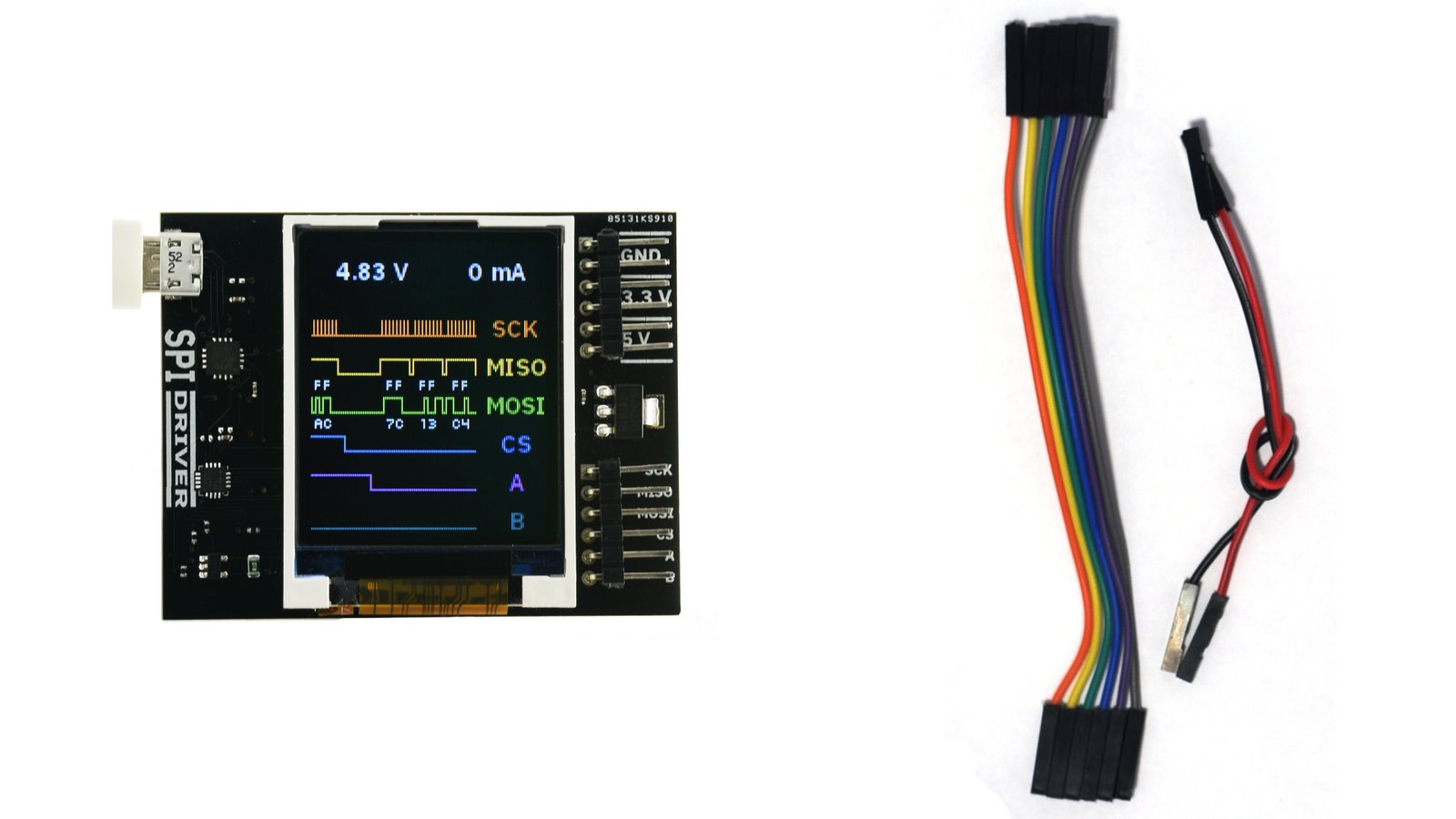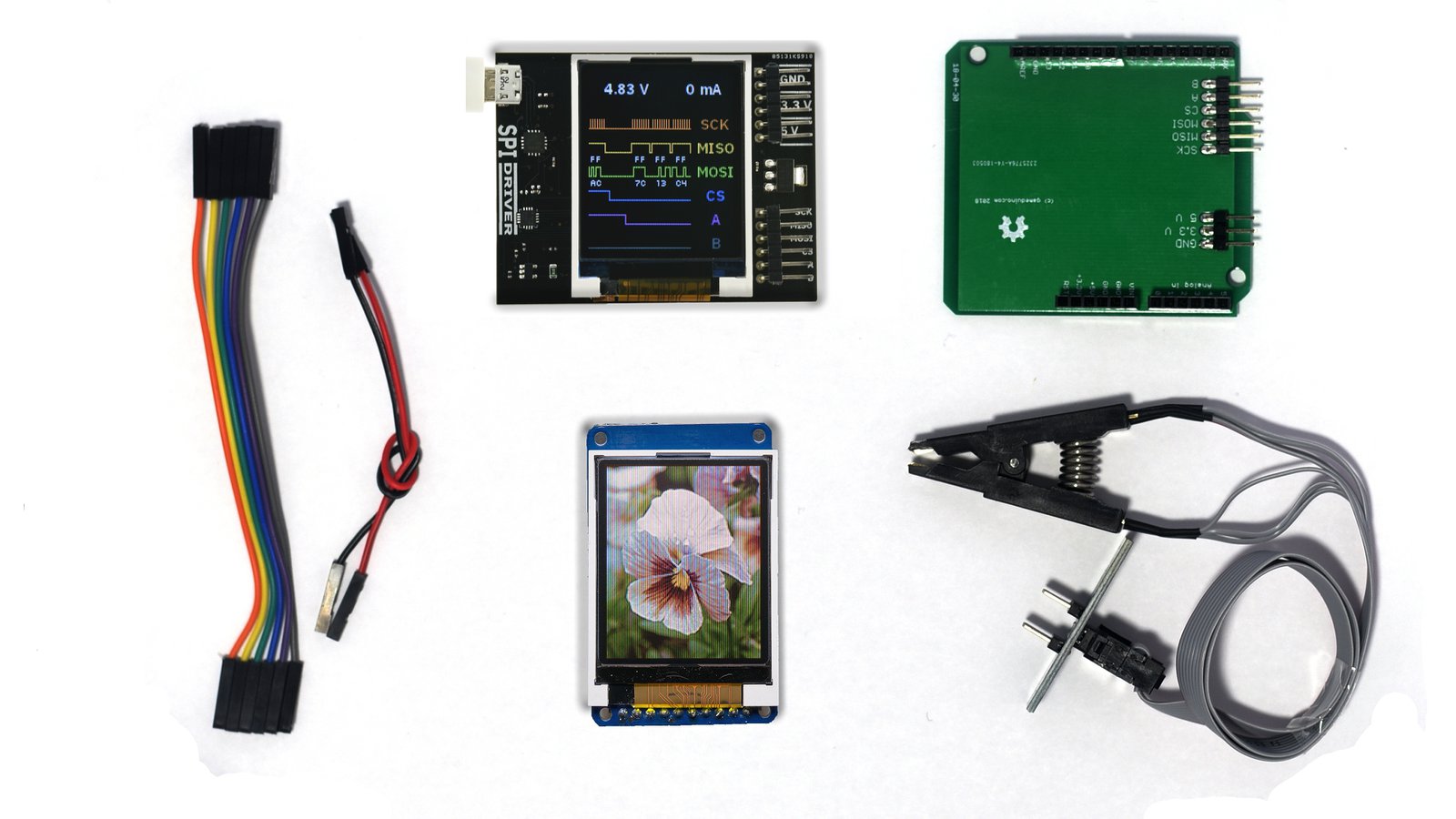Excamera Labs
Protocol Interfaces
SPIDriver
The SPI adapter/multi-tool that lets you easily drive SPI devices from any computer or SBC
Funding ended on Jul 13, 2018 at 04:59 PM PDT.
Excamera Labs
Protocol Interfaces
Funding ended on Jul 13, 2018 at 04:59 PM PDT.
SPIDriver is an easy-to-use tool for controlling SPI devices. It works with Windows, Mac, and Linux, and has a built-in color screen that shows a live logic-analyzer display of all SPI traffic. It uses a standard FTDI USB serial chip to talk to the PC, so no special drivers need to be installed. The board includes 3.3 and 5 V supplies with voltage and current monitoring.
If you use SPI devices - LCD panels, flash memory, sensors, LEDs - you’ll know that the most frequently asked question is "what’s it doing now?" SPIDriver shows you what’s happening on the SPI bus in real time, so no more guessing about the bus state. It’s designed to make talking to SPI hardware a smooth, intuitive process. That’s good whether you’re a hardware debug wizard or are introducing a class to SPI for the first time.
The current and voltage monitoring let you catch electrical problems early. The included color coded wires make hookup a cinch; no pinout diagram required. It includes 3.3 and 5 V supplies for your device, plus a high-side current meter.
SPIDriver comes with free (as in freedom) software to control it from:
If you use SPI hardware, you need SPIDriver. You can directly control LEDs and LCD displays without having to go near a microcontroller. If you need to examine, backup, or clone an SPI flash, SPIDriver is the ideal tool. It can read, backup, and restore standard SPI flash chips in-circuit, and is supported by the popular flashrom tool. If you work with SPI sensors, you can debug, test and calibrate them from your desktop using the programming tools you use every day.
Graphic displays can be a pain, so it can feel like a real achievement getting them to display an image. SPIDriver is a natural fit for driving, testing, and evaluating different displays. Of course, SPIDriver also works perfectly with the Gameduino series of graphic touch screens.
SPI flash is very common, and by using a test clip, SPIDriver makes it convenient to read and write SPI flash in-circuit. Just attach the clip and you can backup and restore flash contents directly. Atmel’s microcontrollers in-circuit programming use standard SPI pins, so a short script is all it takes to read or write an Atmel’s flash.
SPI LED strips are also simple to hook up to SPIDriver, and being able to control them directly makes them much more fun! It’s fast enough to smoothly animate long strips and achieve POV effects. Short strips can be powered directly by the SPIDriver’s beefy 470 mA built-in supply.
| Tool | Open hardware / software | Indicators or display | Additional sensors | No driver install | Host Software | Price (USD) |
|---|---|---|---|---|---|---|
| SPIDriver | Yes | Graphic protocol analyzer | Bus, voltage, current, temperature | Yes | GUI, command-line, Python, C/C++, and flashrom | $27 |
| Totalphase Aardvark | No | None | None | No | Command-line, Python, C/C++ | $300 |
| FTDI MPSSE cable | No | None | None | No | C/C++ | $27.30 |
| Bus Pirate | Yes | Power LEDs | ADC input | Yes | Command-line. Python, flashrom | $27.15 |
PCB manufacture is being handled by JLCPCB in Shenzhen, who have done a great job with the prototypes. We’re assembling and testing the first batch of units here in Pescadero, USA, with components sourced directly from Digikey USA. Each unit goes through an extensive automatic test and calibration, so that the voltage and current sensors are accurate to within 1%. Finally, thanks to ftx-prog, we properly program the FTDI USB chip to allow up to 500 mA over USB instead of the default 90 mA.
Immediately after the campaign closes, I’ll be placing the orders with the manufacturers. We estimate that we’ll have all rewards tested and shipped by August 24th.
The designs have been prototyped through multiple iterations. The firmware has been tested with fanatical thoroughness. This mitigates a lot of risk. The remaining risk is in manufacturing execution:
These are generally the same issues that may occur with any PCBA fabrication.
Produced by Excamera Labs in Pescadero, CA.
Sold and shipped by Crowd Supply.

A SPIDriver, complete with a set of hookup jumpers.
Want to buy this item? Check the current project page for the latest information.

As SPIDriver Expert, plus the SPIDriver's USB Serial ID custom programmed to an 8-character name of your choosing.
Want to buy this item? Check the current project page for the latest information.

Thanks for helping make SPIDriver a reality! You will be rewarded with regular backer updates, and my thanks.
Want to buy this item? Check the current project page for the latest information.

A SPIDriver with hookup jumpers, an Arduino-style SPI adapter, a sweet 160x128 SPI LCD display, and an in-circuit flash programming clip.
Want to buy this item? Check the current project page for the latest information.

I'm dedicated to building useful hardware and software, particularly where embedded systems meet graphics and imaging. Probably my best known public projects are the Gameduino series of game accessory boards, and the J1 CPU. I have benefited immensely from Open Source hardware and software, so I try to open source as much as I can.